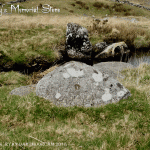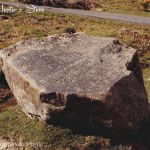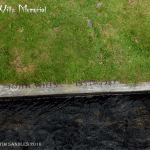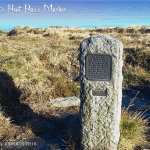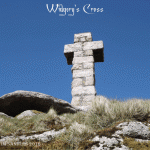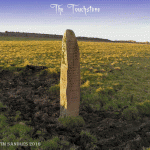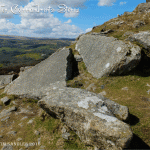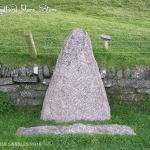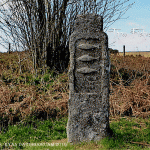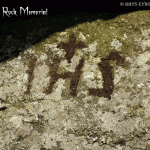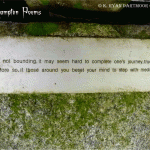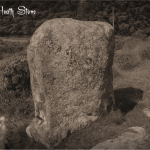
Dartmoor is literally studded with memorials of one kind or another, each and every one has a different association with either a person, event, belief, a pet, etc. They can be found anywhere from the open moor to village greens and virtually every other location imaginable. Many have lost the reason for their existence way back in the mists of time whilst others are more recent in our memories. One could possibly argue that the earliest memorials to be found on Dartmoor are the prehistoric ritual monuments such as menhirs, because it has been suggested that they were erected in memory of some high status person or another.
So what is a memorial? The Oxford English Dictionary define them as something that is: “Preserving the memory of a person or thing; often applied to an object set up, or a festival (or the like), to commemorate and event or a person.” That pretty much hits the nail on the head except there are Dartmoor memorials that commemorate people’s pets, religious beliefs and simple mottoes as well. What format do memorial take on Dartmoor? They include; buildings, memorial plaques, crosses, simple incised letters and dates on rocks, wooden features and walls or a combination of all these. It is virtually impossible to slot each one into a specific category but a simplistic classification here would be; personal memorials which includes a person, group of people or a pet, a specific event in time or a personal belief or quotation.
Personal Memorials.
As far as people go the most obvious place to find memorials to people is in any church or grave yard but leaving these aside there are numerous other memorials that commemorate loved family members dotted around the moor. Virtually in every case they are dedicated to the deceased, either family members or people who have a notable association with Dartmoor or a specific location on the moor. Some comprise of memorial plaques whilst others simply comprise of a persons initials, many also give the dates of birth and death.
By far the most commonest memorials are those who commemorate departed family members many of which can be found on the open moor. In some cases these relate to the deceased favourite spot, view or walk when they were alive. They are normally located near to the spot and often carved into a rock, boulder or some other landscape feature. Another common form of memorial consists of a plaque placed upon a bench or seat which in some cases were bequeathed by the deceased family. Again such Dartmoor memorials can be found in such diverse locations as on tors, in woods, along popular footpaths, beside water or even out in the middle of nowhere. Probably one of the most famous of these is the poet Ted Hughes‘ memorial which is located near to Taw Head. A good example of a simple personal memorial is the one that’s discretely carved into the wooden leat launder under Barn Hill which I bet many people miss.
There are then what I regard as the ‘tragic memorials’ these are ones located at the spot or near to it where people had actually died on Dartmoor. A couple examples of these are the William Donaghy memorial near Hartland Tor. This is carved into a boulder where his body was mysteriously found. There is also the memorial to S. L. Perry, a Royal Marine whose unexplainable death near the northern wall of Fernworthy in 1992 still gets poppies placed on it today. Another category of personal memorials are those dedicated to people who in one form or another have contributed to the love or understanding of the moor. I would suggest that the most visited memorial in this category has to be the memorial to William Crossing which is located on a boulder at Duck’s Pool. Two other examples are the Tom Gant and F. H. Starkey memorials. Like William Crossing both had a great love and knowledge of Dartmoor who passed on their expertise in the form of popular topographical books for future generations to enjoy. Dotted around the various Peat Passes of north Dartmoor are memorial markers to Frank Phillpotts, the man who instigated the cutting or re-cutting of the peat passes. The ‘Hunter’s Stone‘ memorial near to Shipley Bridge is a boulder incised with the names of seven past masters of the Dartmoor Foxhounds, again all men with the love of a Dartmoor hunt. Another famous inscribed memorial can be found on the Dewerstone and commemorates N. T Carrington the famous Dartmoor poet.
In a some cases the memorial may be dedicated to a group of people who all met their deaths at the same time, most of these related to fatalities during a war of some period or another. Nearly every town and village on Dartmoor will have a war memorial to the folk who have lost their lives in the more recent conflicts. Whilst others are located near to the scene where the people actually met their ends. For example the RAF Memorial Stone on Hameldown Hill remembers the four man crew of a Hampden which crashed in the vicinity. Some other World War II aircaft crash sites have simpler memorials to the fallen such as at Tiger’s marsh. An ancient stone cross now known as the Cavalier’s Cross bears witness to the death of a soldier during the English Civil War. In the memorial garden at Princetown Prison there are four memorials dedicated to the French and American prisoners of war who met their deaths at the gaol. Another simple metal plaque in Princetown’s churchyard commemorates the loss of four soldiers who died in a Dartmoor blizzard.
Throughout time people have been accompanied on Dartmoor by animals which mainly include those of the equine or canine varieties. In some cases these animals will have actually been working on the moor such as those hunting, drawing loads or carrying riders. In other instances they will have been accompanying their owners in some leisure activity or another such a hunting, walking for exercise or company. One old example would be the 1875 memorial to a dog called ‘Tiny’ which was to be found on Hangershell Rock another being an epitaph to another dog called ‘Flora’. There are numerous later examples around the moor but the only problem being when just a name and date are given it’s impossible to say if they relate to an animal or human.
Event Memorials.
Again ‘Event Memorials’ are to be found all across Dartmoor in one form or another, all of which show a great diversity of ‘events’ that have led to their existence. There are those that mark the construction of a building, bridge and a whole host of other man-made landscape features. Some of the earliest form of this particular type are those found in many old buildings which tend to commemorate the date of construction, sometimes with the initials of the builder or owners. Quite often these can be found above what was the front door or on a lintel over the fireplace. Probably one of the most commonest construction memorial are those found on bridges, mostly they mark the repair work, widening and in some cases construction, a lot of which can be found on the parapets. Another form of Dartmoor event memorial are those that mark significant royal occurrences such as royal jubilees, royal accessions, coronations, etc. these can be found on crosses such as at Hexworthy. What must be the largest royal memorial is the huge cross known as Widgery’s Cross which was placed on top of Brat Tor to commemorate Queen Victoria’s Golden Jubilee. Other ‘Royal’ locations include on or by trees that were planted in a particular year like the one on North Bovey green, on pillars such as the one on Roborough Common to name but two. Other events that have been commemorated with memorials are the opening of the Two Moors Way, In more recent times there have been several memorials to commemorate the millennium of 2000, one example being the boulder on Widecombe village green which marks the placing of a time capsule. Another example is the ‘Touchstone‘, a granite pillar set in a field with lines of poetry incised into it which was the work of an ex-Governor of Princetown Prison and marks the millennium. One or two other oddities in this category are the Ten Commandment Stones on Buckland beacon, this commemorates Parliament rejection of the proposed common book of prayer. Another is the Corn Law memorial at Hedge Barton which could recognise the repeal of the Corn Laws, despite the date being wrong. Whilst delving into the realms of history, Lydford has two memorial stones, one of which, the ‘Rune Stone’, marks the 1,000th anniversary of a Viking invasion of the settlement in 997AD. Whilst on the subject, there is a gigantic memorial called the ‘Buller Stone’ which sits on the edge of Wistman’s Wood, this marks the occasion when a tree was taken from the wood to establish its age by means of dendrochronology.
Belief Memorials.
The majority of memorials in this category tend to be related to Christian beliefs by way of symbols and words and once again can be found on and around Dartmoor. Dotted around the Beardown Estate are what surely have to be the largest collection of memorials to be found on Dartmoor. Back in the 1800s Mr. Bray decided he wanted to turn his estate into a ‘Druidical Landscape‘ and so commissioned a whole series of inscriptions on various boulders around his lands. Some were dedications to his family, others to Arthurian characters or Celtic gods, and a few to famous poets. Many of these stones have now been lost to the ravages of time and the Dartmoor weather. One of the most impressive of this type are the ‘Three fishes Stones‘ that are located around the Heathercombe Estate. Each of the three pillars shows three carved fish along with doxologies of the Lord’s Prayer. It is said they were placed by the then landowner as a protest about the word-wide abuse of power. In contrast there are much simpler memorials to the Christian faith such as the simple inscription on Pupers Rock which reads ‘IHS’ incised under a cross. On a slightly different tact, around Walkhampton were a series of five plaques which commemorated somebody’s poetical talents and tenets on life, how may exist today nobody is sure. There is or was a rather contentious memorial that expressed a certain persons religious convictions and that is the Heath Stone on Chagford Common. The one-time supervisor of Fernworthy Reservoir had carved onto what was an ancient ritual monument and early boundstone the words; “Jesus said I am the way, the truth and the light.” For this act of devotion he was severely reprimanded by his superiors.
I have tried to find out today’s protocol for placing a memorial on Dartmoor and with regards to land owned by the Duchy of Cornwall one must in every case get their permission. As far as land under the National Park Authority’s control then I have contacted them for an answer and I am awaiting for a reply which can take up to ten days to get??? There can be no question that it is not permissible simply to site, carve or create any kind of memorial without the landowners permission no matter how relevant it might be.
So there you have a very brief synopsis of the various memorials dotted around Dartmoor. Needless to say there will be many more categories under which they could appear and hundreds of examples not mentioned here. It would be interesting to create a database which includes as many memorials as possible and see exactly how large that would be – maybe something for the future?
 Legendary Dartmoor The many aspects past and present of Dartmoor
Legendary Dartmoor The many aspects past and present of Dartmoor

